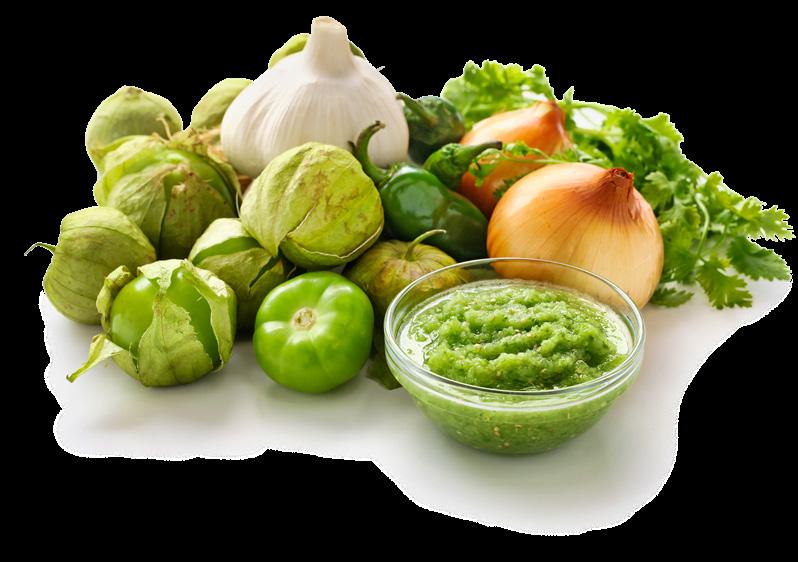
3 minute read
SALSA VERDE
Miscellany
❥Capsaicin, the active element in chiles, is predominately found in the membranes. The seeds are not really the source of the fire, as is commonly believed, but are only affected by being attached to the white pith and thus covered in the oil.
Tomatillos
Tomatillos, often called husk tomatoes, are not especially common in this neck of the woods, but they can be found. They are from the nightshade family and grow encased in a papery calyx - think Chinese lanterns or golden ground cherries. We are lucky to have several excellent Latin markets full of prepared salsas as well as the ingredients needed to make your own.
Not only is a salsa verde superb as a dip, but it also makes one of the best chicken tacos around, and nothing is easier than making a taco.
Salsa Smarts
1-2 serrano or jalapeño peppers
450g (1 lb) tomatillos, husked and rinsed
250 ml (1 cup) cilantro, packed
1 clove garlic, chopped
¹/³ medium white onion, roughly chopped
45 ml (3 Tbsp) lime juice
2.5 ml (½ tsp) ground coriander
2.5-5 ml (½-1 tsp) honey
5 ml (1 tsp) salt
15 ml (1 Tbsp) olive oil
Stem the peppers and remove the seeds and membranes (where most of heat reside)* Put the whole lot into a blender and puree until quite smooth. Taste to adjust salt and lime juice. You’re done.
This salsa will stay fresh for a few days refrigerated, but it freezes very well too.
❥The Scoville Heat Unit (SHU) chart really helps to get an idea of what to expect from chiles vis a vis hotness. For example, bell peppers are 0 on the scale with the Carolina Reaper weighing in at up to 2,000,000.
MAKE TACOS! To make one of the best tacos you’ll ever eat, gently simmer shredded chicken in salsa verde. Toast small flour (or corn) tortillas in a very hot pan and build your taco with the chicken, the warm sauce, cold crisp shredded cabbage slaw, sliced avocado, and grated mild cheese. Squeeze some fresh lime over it all and dig in.
¡Ya está!
A Word On Fruit Salsas
Since tomatoes, peppers, avocadoes (yes, guacamole is a salsa!), and tomatillos are technically fruits, all salsas are fruit salsas. However, mangoes, pineapples, papayas, oranges, jicama and even cucumbers come together to create something else entirely. Served as a chopped salad next to spicy grilled porkchops or swordfish, a tropical mango and pineapple salsa, with the crunch of chopped jicama and doused in lime juice and cilantro, is sublime.
❥You can moderate the spiciness of any chile by removing the insides... or not.
❥It’s a good idea to use gloves and resist the urge to touch your eyes and other mucous membranes.
❥If a recipe calls for Mexican oregano, don’t substitute the Italian pizza sort – just do without. The Mexican variety has a minty, citrus-y flavour that, just can’t be duplicated.
❥Roasting your vegetables (tomatoes, onions, peppers, tomatillos, etc.) before chopping or blending imparts an added layer of smoky charred flavour. Different, but not necessarily always better.
❥Many salsas are prepared raw and meant to be consumed within a short period of time, if not immediately. Many are cooked, however, and are ideal for canning and enjoying out of season, right out of the jar. Just be sure the recipe you use is properly adapted to the canning process. Ph balance is important.
What is the active ingredient in chile peppers?
What fruit is most commonly used to make salsa verde?

If you can’t find serrano peppers, what makes a good (and easy to find) substitute?
What could you use to make a fine textured salsa if you didn’t have a blender or food processor?
How is heat measured in chili peppers?
Find the answers to last issue's quiz on Page 29.
Submit your answers to info@savourcalgary.ca to enter to win a large gourmet box from Epicureans Co. in Canmore.









Top Of The Class
Lovers of wine, spirits and beer can be … passionate. And let’s face it, once you start learning about your favourite sips, you discover that the more you learn, the less you know. Fortunately, Calgary’s independent liquor stores will keep you at the top of the class with dozens of courses, seminars, workshops and tastings available every month. Take your Wine and Spirit Educational Trust (WSET) training or go for something less formal at Willow Park Wines and Spirits, whose courses start at $25 and range from pairings for your Stampede barbecue to a master class in pinot noir to a lesson on making gin cocktails. If whiskey is more your speed, check out Kensington Wine Market ’s Scotch Malt Whisky Society Canada membership and events for access to single malts you can’t get anywhere else with tasting events both in-store and online.
Willow Park Wines and Spirits Classes

Starting at $25 | willowpark.net

Scotch Malt Whisky Society Membership
Kensington Wine Market | Starting at $125 smws.ca










